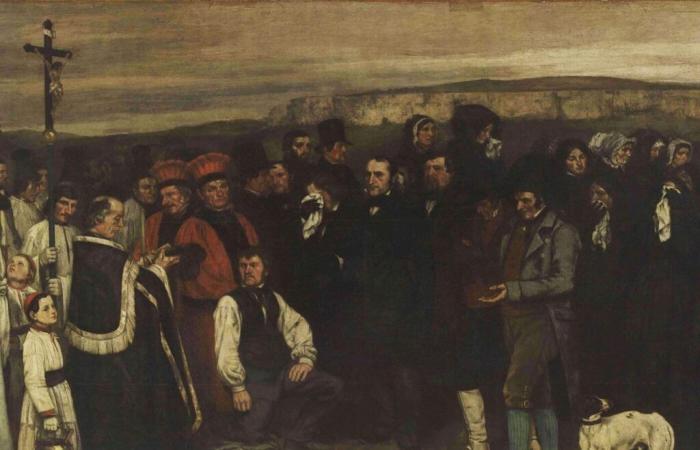Announced in April 2024, the ambitious restoration ofA burial in Ornans (1849–1850), monumental table of the painter Gustave Courbet and one of the centerpieces of the Orsay Museumhas just started on the ground floor of the Parisian establishment.
In Salle 7 where it is usually hung, a palisade specially designed for the occasion surrounds the workspace so that visitors can, through transparent openings, in Observe the meticulous process which will last between 12 and 18 months.
A necessary and complex operation
“The preservation of Courbet’s original gestures – its traces of brush, the streaks of its knife, the assumed irregularities of its material – constitutes a primordial issue. »»
The painting, which had “not been the subject of a fundamental intervention for half a century”, “requires being restored” for several reasons, explains the museum. The most obvious is aesthetic: The different layers of ancient varnish Who cover it, “yellowed, thickened and opacified” over time, “compromise its reading”.
Already characterized by a earthy palette, the work with 46 characters has indeed become difficult to decipherand even entirely black in places. The tinkering and reduction of varnishes, which will constitute the first stage of the site, will therefore allowImprove its overall appearance and reading But also, perhaps, to reveal masked details, as was the case recently for Freedom guiding the people D’Eugène Delacroix at the Louvre.
Gustave Courbet, Detail of the draft of an “burial to Ornans” seen through the radiographybetween 1849 and 1850
-i
© C2RMF / Laurence Clivet and Alexis Komenda
Other deeper reasons made this urgent restoration. “Distorted”, his 1884 chassis had “caused a relaxation of the canvas and the fragility of its seams “, while” the instability of certain binders “, combined with a complex superposition of layers of painting, had led “Targets” and “Localized uprisings”. The multiple trips of the table since its creation 175 years ago had also had the consequences of many “folds, deformations and tears”. The canvas will therefore be “Consolidated and reassembledeither on a new chassis, or on the old reinforced chassis “, then the different gaps and wear” attenuated “.
For restaurateurs, this “Large operation” installation of “specific challenges”, not only because of the Exceptional size of the work (seven meters out of three) but also technique expressive of the painter, “characterized by generous impastors and applications sometimes made with a knife”. ” There Preservation of original gestures de Courbet – his traces of brush, the streaks of his knife, the assumed irregularities of his material – constitutes a key issue, “insists the team. Rigor and prudence will therefore be in order.
Visits to follow the catering work
Financed thanks to the patronage of the Bank of America Charitable Foundation, this restoration intervenes Ten years after that of another colossal table by Courbet kept in Orsay, The painter’s workshop (1854–1855). This delicate mission will be carried out, in collaboration with a scientific committee, by Seven restaurateurs of the Arcana Workshopincluding Cinzia Pasquali, who has already directed the restoration of the Apollo gallery at the Louvre and the Galerie des Glaces at the Château de Versailles, and gave a freshness to mythical paintings like The Virgin, the Child Jesus and Saint Anne de Léonardo da Vinci (preserved at the Louvre).








